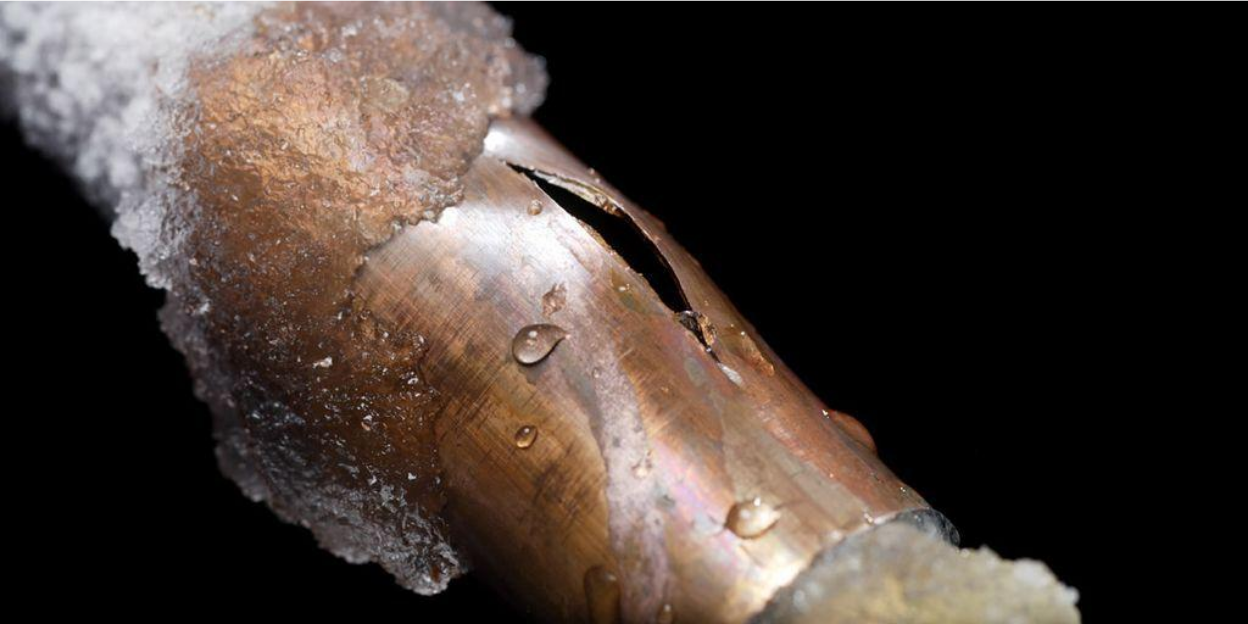Ghost of Christmas Past – Pipe Freezes

Frozen pipes can result in disaster, but they don’t have to. Moving quickly with knowledgeable guidance can prevent problems from occurring and mitigate the damages when they do.
BEFORE FREEZING TEMPERATURES
Building design professionals will typically ensure that water supplies and drains are constructed away from exterior walls to prevent freezing. However, in some circumstances, particularly in older homes or buildings, supplies and drains could be in places that you would not expect or ideally want.
The first step in understanding how to prevent frozen pipes in your property is to determine where those pipes are that are most at risk. If you aren’t sure, hire a plumber or licensed general contractor to help you source the locations of any pipes that may be problematic in extreme cold weather conditions.
A knowledgeable general contractor can also help inspect your property to determine if there are any construction defects that could unexpectedly create vulnerabilities in the property. Once you’ve identified any areas of concern, you can begin planning how to best deal with them to prevent a freeze. The appropriate engineering solutions will depend on the situation and location of the area that you are looking to protect.
Other preventative measures:
- Add a secondary source of heat safe for indoor use to any areas where supplies or drains may be vulnerable to freezing.
- Close any doors in rooms where it will help maintain warmer temperatures in those vulnerable areas.
- Leave open kitchen and bathroom cabinet doors that contain plumbing drains and supplies if they are vulnerable to freezing.
- Turn faucets on so they very lightly drip if they are vulnerable to freezing.
- If you're away from home for several days, set your thermostat to at least 55 degrees to keep interior plumbing warm enough to prevent freezing.
WHEN A PIPE IS AFFECTED
If you have discovered a pipe has frozen, you must move quickly to prevent damage. In older construction, you’ll generally have copper pipes that are soldered together to bring water to the sinks, toilets, and sometimes radiators. Those older buildings can also have cast iron drains. In newer construction, plastic piping commonly called PEX tubing is used to supply water to the fixtures in lieu of copper, and drains are constructed of plastic PVC piping. While the PEX tubing and PVC are both more resilient to freezing than their predecessors, all can fail in the event of a freeze. To understand how to respond, it’s best to understand what is occurring that causes the damage in the first place.
A frozen pipe is not necessarily a problem on its own. Water pipes are designed to expand and contract to a certain degree, and most water supply and drain pipes will typically not be damaged by freezing alone. The problem occurs when fluids within a pipe freeze, because as the fluid freezes, it expands in place. If this expansion is greater than the pipe can withstand, the sides of the pipe may splinter and crack. Once the fluids thaw, the liquid will escape through those splinters and cracks created by the freeze, as will the fluids the frozen portion of the pipe was holding back. This often results in large amounts of water being released onto the property.
If you find that a pipe has frozen, generally evidenced by a lack of water flow or stoppage, a few steps can help resolve the issue without causing damage.
- Locate any shut off valves before the frozen portion of any water supply line and turn the valve off. If pipes are frozen in multiple areas, turning off multiple shut off valves or the main water supply for the property may be required.
- If part of a baseboard or hot water heating system has frozen, it can become an emergency because failures in that system can require you to turn off the heat supply. If you must turn off the main water supply or the heating system is frozen, call a plumber immediately.
- Once you have turned off the water supply to the affected area(s), turn on the taps to any fixtures located after the frozen supply line. This will release some of the water pressure on the supply line by allowing some of the unfrozen fluid to escape as the pipes thaw.
- Then inspect the frozen portion(s) of the pipes. If no cracks or splintering are visible, you can safely add a secondary source of heat, safe for indoor use, to begin thawing that portion of piping.
- If cracks or splintering is visible, the entire water system should be drained before any heat is added to thaw the pipes.
- Additionally, measures should be taken to clean up and extract any water that is released from the pipes after they are thawed. If the system has been drained, the water cleanup will generally be manageable with wet/dry vac, towels, mops, and general personal protective equipment like rubber gloves and safety goggles.
- If drains have frozen, the fluid contained within them is likely hazardous and should not be handled by untrained personnel. Attempt to thaw frozen drains only if you can confirm they do not have any visible cracks or fractures. Drains can be safely thawed, if not damaged, with the use of a secondary heat source safe for indoor use.
AFTER A FROZEN PIPE
After following these steps, and/or if the pipes have frozen and you have sustained any serious water damage:
- Seek safe shelter.
- Contact a qualified public adjuster like Eastern Public and/or an emergency mitigation contractor.
- The PA will help provide the resources and guidance needed to manage your recovery effectively.
- The emergency mitigation contractor will be prepared to clean up and dry out the property in emergency conditions.
- Notify your insurance carrier of the occurrence once you’ve consulted with your public adjuster and/or insurance agent/broker.
Eastern Public is a complete property insurance claims and risk management firm based in New York. With over 20 years of experience, we are licensed to serve clients in the greater New York City area and across the East Coast, including New York, New Jersey, Pennsylvania, Connecticut, Massachusetts, Vermont, Maine, Rhode Island, DC, Maryland, North Carolina, South Carolina, Kentucky, and Georgia. For 24/7 claims advice and service, contact us at (929) 999.4674 or info@EasternPublic.com .
Our Work
News & Press







